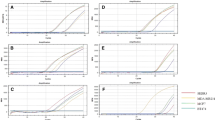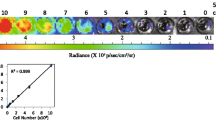Abstract
The aim of this study was to develop a new method for detecting circulating tumor cells (CTCs) in breast cancer patients by using the telomerase-specific replication-selective adenovirus OBP-401. Once transfected, OBP-401 can replicate only in telomerase expressing cells and emit fluorescence as it replicates so that the transfected cells become easily recognizable. Peripheral blood samples were drawn from 50 metastatic breast cancer patients and 27 early breast cancer patients. Blood samples were subjected to both the OBP-401 and CellSearch assays for the detection of CTCs and the results were compared. The recovery rate of the OBP-401 assay was one CTC in 7.5 ml blood combined with high specificity since no CTC was observed in 80 healthy controls. In 50 metastatic patients, 21 patients (42%) were identified as positive with the OBP-401 assay and 27 patients (54%) with the CellSearch assay. The CellSearch assay showed a significantly higher positivity for hormone receptor (HR)-positive tumors (estrogen receptor and/or progesterone receptor-positive tumors) (61%, 25/41, P = 0.012) or CA15-3-positive tumors (69%, 24/35, P = 0.003) than for HR-negative tumors (13%, 1/8) or CA15-3-negative tumors (21%, 3/14), respectively. Contrary, the OBP-401 assay results were similar regardless of their HR status (positive: 44% vs. negative: 38%, P = 0.738) or CA15-3 positivity (positive: 40% vs. negative: 50%, P = 0.523). Of the 27 early stage patients, four patients (15%) were identified by the OBP-401 assay and by the CellSearch assay, respectively, but there was no overlap in the CTCs-positive patients. In conclusion, the OBP-401 assay is comparable to the CellSearch assay in the detection rate of CTCs in both metastatic and early breast cancer patients. However, there was a great discrepancy in patients with CTCs between both assays. The OBP-401 assay may isolate CTCs with other biological characteristics which CTCs detected by the CellSearch assay do not have.




Similar content being viewed by others
References
Cristofanilli M, Hayes D, Budd T et al (2005) Circulating tumor cells: a novel prognostic factor for newly diagnosed metastatic breast cancer. J Clin Oncol 23:1420–1430
Pachmann K, Camara O, Kavallaris A et al (2008) Monitoring the response of circulating epithelial tumor cells to adjuvant chemotherapy in breast cancer allows detection of patients at risk of early relapse. J Clin Oncol 26:1208–1215
Liu M, Shields P, Warren R et al (2009) Circulating tumor cells: a useful predictor of treatment efficacy in metastatic breast cancer. J Clin Oncol 27:5153–5159
Pantel K, Brakenhoff R, Brandt B (2008) Detection, clinical relevance and specific biological properties of disseminating tumor cells. Nat Rev Cancer 8:329–340
Mostert B, Sleijfer S, Foekens J, Gratama JW (2009) Circulating tumor cells (CTCs): detection methods and their clinical relevance in breast cancer. Cancer Treat Rev 35:463–474
Cohen SJ, Alpaugh RK, Gross S et al (2006) Isolation and characterization of circulating tumor cells in patients with metastatic colorectal cancer. Clin Colorectal Cancer 6:125–132
Moreno JG, Miller MC, Gross S et al (2005) Circulating tumor cells predict survival in patients with metastatic prostate cancer. Urology 65:713–718
Budd T, Cristofanilli M, Ellis M et al (2006) Circulating tumor cells versus imaging–predicting overall survival in metastatic breast cancer. Clin Cancer Res 12:6403–6409
Riethdorf S, Müller V, Zhang L et al (2010) Detection and HER2 expression of circulating tumor cells: prospective monitoring in breast cancer patients treated in the neoadjuvant GeparQuattro trial. Clin Cancer Res 16:2634–2645
Yagata H, Nakamura S, Toi M et al (2008) Evaluation of circulating tumor cells in patients with breast cancer: multi-institutional clinical trial in Japan. Int J Clin Onccol 13:252–256
Kojima T, Hashimoto Y, Watanabe Y et al (2009) A simple biological imaging system for detecting viable human circulating tumor cells. J Clin Invest 119:3172–3181
Hiyama E, Gollahon L, Kataoka T et al (1996) Telomerase activity in human breast tumors. J Natl Cancer Inst 88:116–122
Iwama H, Ohyashiki K, Ohyashiki J et al (1998) Telomeric length and telomerase activity vary with age in peripheral blood cells obtained from normal individuals. Hum Genet 102:397–402
Soria J-C, Gauthier L, Raymond E et al (1999) Molecular detection of telomerase-positive circulating epithelial cells in metastatic breast cancer patients. Clin Cancer Res 5:971–975
Kishimoto H, Kojima T, Watanabe Y et al (2006) In vivo imaging of lymph node metastasis with telomerase-specific replication-selective adenovirus. Nat Med 12:1213–1219
Sieuwerts A, Kraan J, Bolt J et al (2009) Anti-epithelial cell adhesion molecule antibodies and the detection of circulating normal-like breast tumor cells. J Natl Cancer Inst 101:61–66
Thiery JP (2002) Epithelial-mesenchymal transitions in tumor progression. Nat Rev Cancer 2:442–454
Yilmaz M, Christofori G (2009) EMT, the cytoskeleton, and cancer cell invasion. Cancer Metastasis Rev 28:15–33
Aktas B, Tewes M, Fehm T et al (2009) Stem cell and epithelial-mesenchymal transition markers are frequently overexpressed in circulating tumor cells of metastatic breast cancer patients. Breast Cancer Res 11:R46. doi:10.1186/bcr2333
Fehm T, Hoffmann O, Aktas B et al (2009) Detection and characterization of circulating tumor cells in blood of primary breast cancer patients by RT-PCR and comparison to status of bone marrow disseminated cells. Breast Cancer Res 11:R59. doi:10.1186/bcr2349
Deng G, Herrler M, Burgess D et al (2008) Enrichment with anti-cytokeratin alone or combined with anti-EpCAM antibodies significantly increases the sensitivity for circulating tumor cell detection in metastatic breast cancer patients. Breast Cancer Res 10:R69. doi:10.1186/bcr2131
Bonnomet A, Brysse A, Tachsidis A et al (2010) Epithelial-to-mesenchymal transitions and circulating tumor cells. J Mammary Gland Biol Neoplasia 15:261–273
Lu J, Fan T, Zhao Q et al (2010) Isolation of circulating epithelial and tumor progenitor cells with an invasive phenotype from breast cancer patients. Int J Cancer 126:669–683
Hayes DF, Zurawski VR Jr, Kufe DW (1986) Comparison of circulating CA15-3 and carcinoembryonic antigen levels in patients with breast cancer. J Clin Oncol 4:1542–1550
Nishimura R, Nagao K, Miyayama H et al (2003) Elevated serum CA15-3 levels correlate with positive estrogen receptor and initial favorable outcome in patients who died from recurrent breast cancer. Breast Cancer 10:220–227
Punnoose EA, Atwal SK, Spoerke JM et al (2010) Molecular biomarker analyses using circulating tumor cells. PLoS One 5:e12517. doi:10.1371/journal.pone.0012517
Cristofanilli M, Broglio KR, Guarneri V et al (2007) Circulating tumor cells in metastatic breast cancer: biologic staging beyond tumor burden. Clin Breast Cancer 7:471–479
Rack B, Schindlbeck C, Andergassen U et al (2010) Prognostic relevance of circulating tumor cells in the peripheral blood of primary breast cancer patients. Cancer Res 70(24 Suppl):93s (abstract# S6-5)
Acknowledgments
We thank Drs N. Maruyama, T. Tanei, M. Okishiro, S. Michishita, M. Nishio, and R. Fukushima for their help for obtaining informed consents and collecting blood samples, and also all patients who participated in this study. This study was supported by the Research grant from Sysmex Corp. (J070701315 to S.N.).
Author information
Authors and Affiliations
Corresponding author
Rights and permissions
About this article
Cite this article
Kim, S.J., Masago, A., Tamaki, Y. et al. A novel approach using telomerase-specific replication-selective adenovirus for detection of circulating tumor cells in breast cancer patients. Breast Cancer Res Treat 128, 765–773 (2011). https://doi.org/10.1007/s10549-011-1603-2
Received:
Accepted:
Published:
Issue Date:
DOI: https://doi.org/10.1007/s10549-011-1603-2




